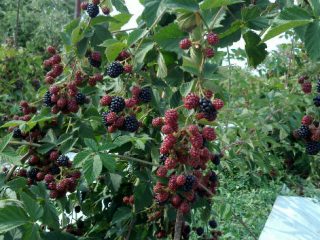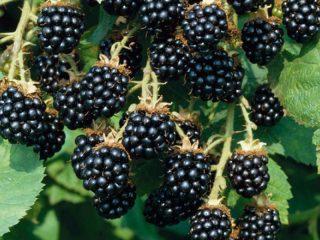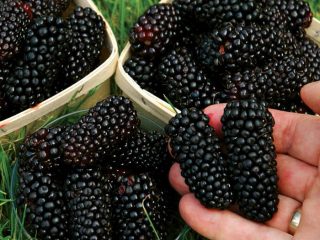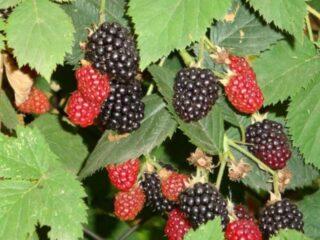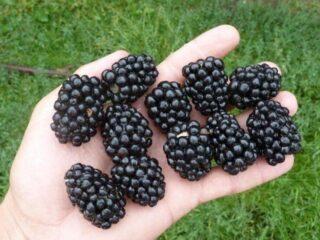Content
Osage blackberry is a new variety of fruit and berry crop, which has become a striking example of the successful work of breeders. The bushes of the plant do not have thorns, which makes harvesting much easier, and the berries are not only tasty and sweet, but also very healthy. Every year the variety becomes more and more popular among gardeners and summer residents.
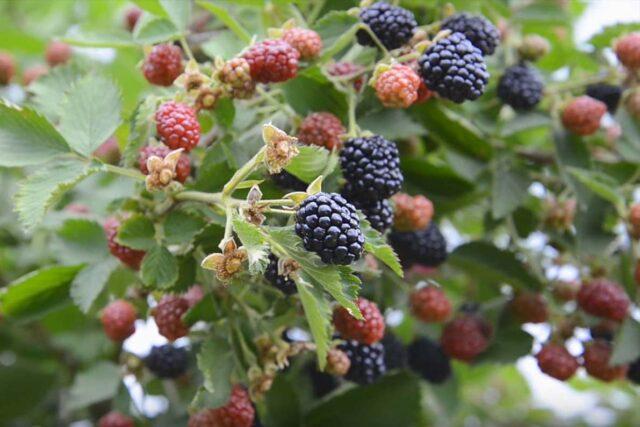
Osage blackberries have high vigor
History of selection
The variety was bred in the United States of America by scientist John Clark in 2012. It took specialists from the University of Arkansas 12 years to produce this tasty and aromatic variety. As a result, Osage blackberry appeared due to cross-pollination of seedlings A-1719T and A-2108.
External description of Osage blackberries
The bushes of this variety are characterized by medium spreading and tallness. The crop grows upright, the shoots are strong, reach a length of 170 cm, and have no thorns. Osage blackberry leaves are dark green in color and have pointed, toothed tips.The variety blooms with medium-sized buds, pink-red in color, with a slight purple tint. There are many clusters, grow in a vertical direction, form black round berries of medium parameters, weighing about 5 g. Ripe fruits hang on the branches for a long time, do not fall off and do not bake in the bright sun.
Characteristics of Osage blackberries
Osage blackberries are the result of many years of work in the field of improving the quality of the crop. The main characteristics of the plant include: resistance to lack of moisture, strong immunity to infections, excellent presentation, keeping quality, and the ability to be transported over long distances. In addition, the authors managed to raise the taste of Osage to a new level. Ripe berries are very sweet, juicy, with dense pulp and a pleasant fruity aroma.
The fruits can be eaten fresh, used for making confectionery, baking, canning, the berries do not lose their shape and quality after freezing. The variety demonstrates excellent industrial potential and can be grown for subsequent sale.
Ripening time and yield
Osage blackberries are early-ripening, productive varieties. Fruiting of the crop lasts for 40 days. It starts around mid-June and lasts until August. The average yield of the variety is about 5 kg per bush. Harvesting begins when the blackberries are dark in color and fully ripe. The procedure is carried out carefully, trying not to press on the berries. The harvest is immediately harvested in a cool place, where it can lie without loss of quality for up to 20 days.
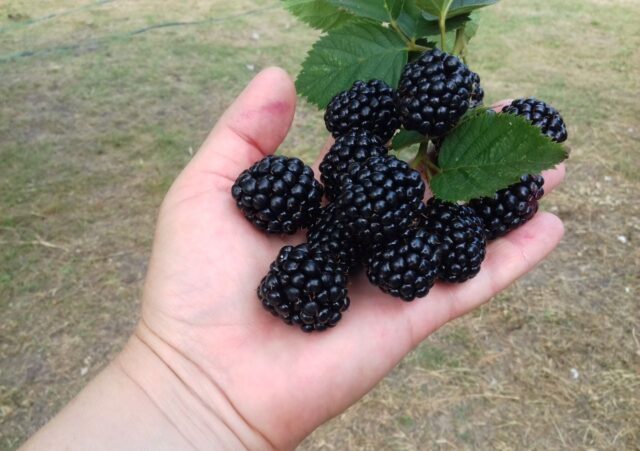
Osage berries do not ripen after picking.
Frost resistance of Osage blackberries
The variety's resistance to low temperatures has not yet been well studied, but, according to the originator, an adult Osage blackberry bush can withstand frosts only down to -13 ° C. For many Russian regions, this is an indicator of rather weak winter hardiness, therefore, with the onset of late autumn, it is recommended to bend the shoots of the crop to the ground and cover it.
Resistance to diseases and pests
Osage blackberries are rarely affected by insects and diseases, but in order to be sure to avoid problems, it is advisable to place their bushes as far as possible from raspberries. It is also worth carrying out preventive work from time to time: getting rid of weeds, loosening the soil, preventing excess moisture, and carrying out seasonal treatments.
The most common diseases that can harm blackberries include purple spot, anthracnose, septoria, gray rot, powdery mildew, curl and mosaic.
As for insects, most often blackberry plantings are attacked by mites or aphids.
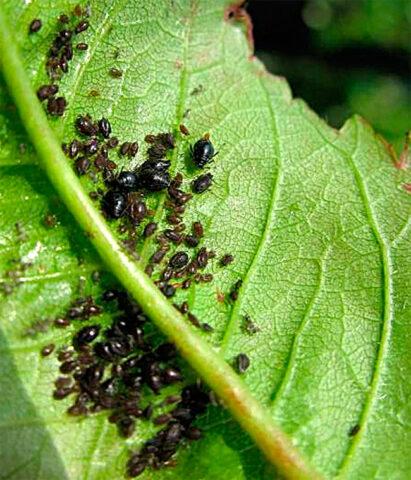
To prevent pest invasion, after winter the bushes need to be treated with soda, acaricides or insecticides
Pros and cons of the variety
The advantages of the Osage blackberry variety far outweigh the disadvantages, and the quality of the berries merits the variety's distribution.
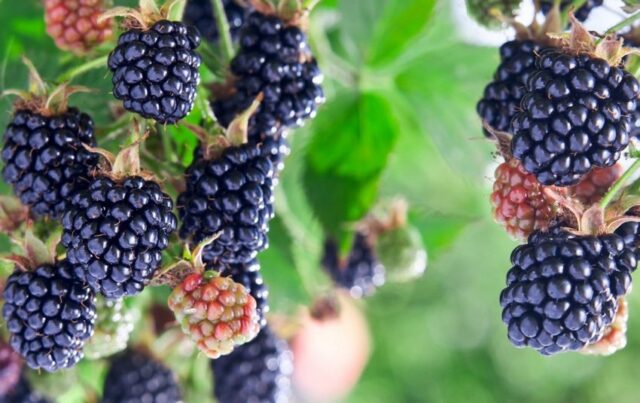
The crop grows well and bears fruit in one place for up to 15 years
Advantages:
- high taste qualities;
- simplified care;
- absence of thorns;
- productivity;
- keeping quality;
- transportability;
- versatility in the use of fruits;
- drought resistance.
Flaws:
- difficulty in acquiring planting material;
- low resistance to low temperatures.
Osage blackberry planting rules
In order for a plant to grow well and produce a bountiful harvest, it must be planted correctly. Osage blackberries prefer loams, areas with a neutral level of soil acidity, and do not tolerate calcareous and alkaline soil. The culture feels best on slightly acidic soil. Choose a place for planting that is windless, sunny, and light partial shade is allowed. Planting work is carried out in the spring, after the ground has warmed up well and the air temperature is consistently above zero. If Osage blackberries grow in southern regions, then planting can, and even preferably, be done in the fall.
For planting, one-year-old sprouts with a developed and strong root system, as well as at least two shoots and one bud at the base, are used.
Two weeks before work is carried out, deep (500 cm) holes are dug at the site, filled with 125 g of superphosphate, 50 g of potassium nitrate and organic fertilizers. River sand is added to dense soil, and weathered peat is added to slightly acidic soil. Before planting, the holes are filled with water, allowed to soak in, two seedlings are placed inside, the roots are straightened, covered with earth, compacted, watered, and mulched with sawdust or straw. After this, the sprouts are trimmed, leaving 20 cm in length.
Osage Blackberry Care
For the full development of a culture, it is necessary to provide it with proper care. Despite the fact that Osage blackberries are considered unpretentious and not capricious, basic rules of agricultural technology must be followed:
- Hydration.The variety is famous for its resistance to drought, but during the growing season and the formation of berries it requires abundant watering, after which the soil is loosened, weeds are removed, and the beds are mulched.
- Fertilizer. A couple of years after planting, Osage begins to be fed. In the spring, ammonium nitrate is added, at the time of fruit formation and before wintering - organic fertilizers, phosphorus and potassium. The culture responds well to rotted compost and humus.
- Formation. During the growth period, blackberries require support, so during cultivation they are tied to trellises wrapped with wire, which are installed at a height of at least two meters.
- Trimming. The procedure is performed when the central stems grow to 1 m in height. Their tops are cut off by 15 cm. Side branches are shortened by 10 cm when growing up to 0.5 m. With the arrival of spring, all frozen stems of Osage blackberries are removed, and in the fall, unproductive and weak shoots, broken and dry branches are cut off.
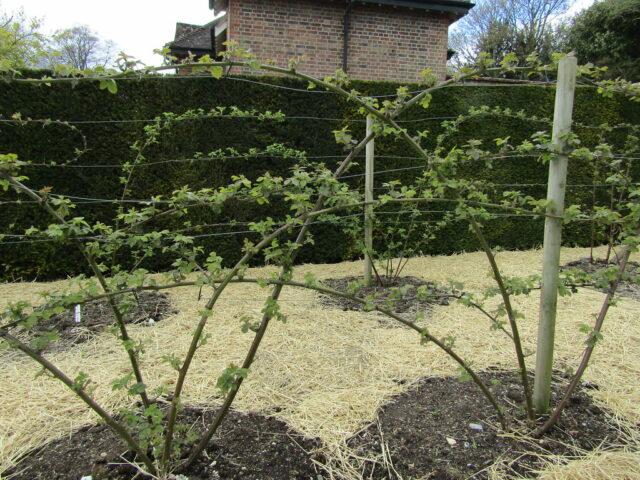
Support helps Osage blackberry stems avoid breaking and sagging.
How to prepare for winter
Osage blackberries do not tolerate frost well, so after picking the berries, gardeners must carry out pre-winter preparation of the crop:
- Untie the shoots of the plant from the support.
- Cut off all weak and dry branches.
- Shorten the stems by 1/3.
- Remove debris, fallen leaves, and mulch from the garden bed.
- They dig up and fertilize the bush near the trunk circle.
- Perform mulching.
- Bend the shoots to the ground and fix them on an oval shape.
- Cover with non-woven material, straw or spruce branches.
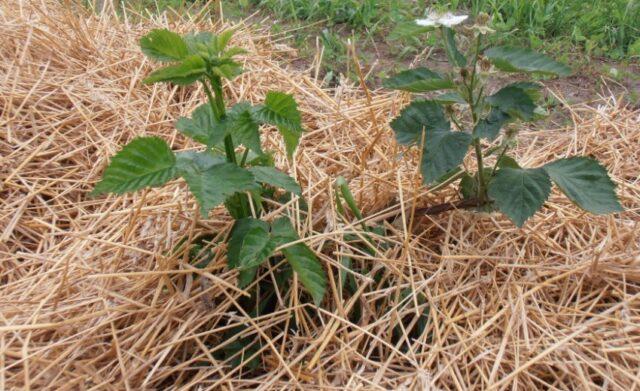
A layer of mulch helps keep the Osage blackberry roots from drying out and freezing during the winter.
How does it reproduce
Osage blackberries are propagated by division, cuttings and root shoots. The first method is most often used when transplanting bushes. To do this, they are carefully dug up, young shoots with a well-developed root system are separated and planted on the site. During the procedure, the old branches of the mother bush are cut off, leaving only strong young shoots. The second method is labor-intensive, but makes it possible to preserve all the varietal characteristics of the crop. From young shoots of an adult plant, the tops with 2-3 buds are cut off, divided into parts, and dipped in a growth stimulator. Then the sprouts are planted in paper cups covered with peat and sand (1:1), placed in a greenhouse, maintaining a temperature of +22 °C. After a month and a half, the seedlings are transferred to a permanent place.
To propagate Osage blackberries by root shoots, productive bushes are selected, from which sprouts with roots are separated. They do this at the end of spring. Select strong seedlings 20 cm high and 0.5 cm thick and plant them in the ground.
Conclusion
Osage blackberries are a promising variety with excellent quality berries. The plant is unpretentious; even inexperienced gardeners can easily grow it. If you follow the recommended rules of agricultural technology, Osage will bring a generous harvest, which can not only be used fresh and for preparing preparations, but also frozen for the winter.
Reviews from gardeners about Osage blackberries


